Human Anatomy and Physiology > QUESTIONS & ANSWERS > HESI A2 Anatomy and Physiology Already Passed (All)
HESI A2 Anatomy and Physiology Already Passed
Document Content and Description Below
HESI A2 Anatomy and Physiology Already Passed Anatomic Position The body is erect, the feet are slightly apart, the head is held high, and the palms of the hands are facing forward. Superior Abo... ve Inferior Below Anterior Facing forward Posterior Toward the back Medial Toward the midline Lateral Away from the midline; towards the side Proximal closer to point of attachment Distal Farther away from point of attachment Histology Study of tissues Epithelial cells Cover, line, and protect the body and its internal organs Connective tissue Framework of the body, providing support and structure for the organs; Types of Connective Tissue: Cartilage, Adipose, and Smooth Nerve Tissue Composed of neurons Tissue Group of cells that act together to perform specific functions Neuroglia Neurons and connective tissue cells that make of nerve tissue Muscle Tissue -Classified as voluntary muscle (skeletal muscle) or involuntary muscle (smooth and cardiac muscle tissue) -Have the ability to contract or shorten Cell Basic unit of life and the building blocks of tissues and organs Nucleus Contains DNA Ribosomes -Synthesis of proteins -Proteins include the enzymes that regulate all chemical reactions within the body Mitosis -Necessary for growth and repair -DNA is duplicated and distributed evenly to two daughter cells Meiosis -Cell division that takes place in the gonads (ovaries and testes); -Chromosome number reduced from 46 to 23 so when the egg and the sperm unite in fertilization, the zygote will have correct number of chromosomes Skin -Largest organ in the body -Epidermis (outermost); Dermis (underlying) Epidermis Outermost protective layer made of dead, keratinized epithelial cells Dermis -Underlying layer of connective tissue with blood vessels, nerve endings, hair follicles, glands, and the associated skin structures -rests on subcutaneous tissue that connects the skin to the superficial muscles Layers of Epidermis (Outer to Inner) (C)ome (L)et's (G)et (S)un (B)urned! 1. Stratum corneum 2. Stratum Lucidum 3. Stratum granulosum 4. Stratum germinativum (stratum basale and stratum spinosum) This is where mitosis occurs Melanin Epidermal cells contain this which protects against radiation from the sun Eccrine Most widely distributed sweat gland, regulates body temperature by releasing watery secretions that evaporate on the surface of the skin Apocrine -Sweat gland in the armpits and groin area -This secretion contains bits of cytoplasm from the secreting cells -This cell debris attracts bacteria resulting in body odor Sebaceous glands Releases an oily secretion (sebum) through hair follicles that lubricates the skin and prevents them from dying Holocrine -Sebum is produced by holocrine secretion -These glands are susceptible to becoming clogged and attracting bacteria Keratin strong protein that hair and nails are composed of Skeletal System Functions Support, movement, blood cell formation (HEMOPOIESIS), protection of internal organs, detoxification, provision for muscle attachment and mineral storage (particularly Ca and P) Hemopoiesis Blood cell formation Long bone -Has an irregular epiphysis at each end -Composed mainly of spongy (needle-like structures) (cancellous) bone -Shaft or diaphysis composed mainly of compact bone Short Bone -As long as they are wide, cube shaped or round -Carpal bones of wrist, tarsal bone of foot Flat Bone -No medullar cavity, thin, thinner on one end -Ribs, hip bone, frontal, parietal, occipital bones of skull Irregular Bone -Do not fit criteria of long, short or flat -Vertebrae, sacrum Sesamoid Bone -Only 2 -Patella and pisiform bones Osteoblasts -Cells that form compact bone -When they become fixed in the dense bone matrix, they stop dividing but continue to maintain bone tissue as Osteocytes Axial Skeleton Consists of: Skull, vertebral column, 12 pairs of ribs, and sternum Skull is comprised of how many bones? -28 bones (14 facial, and 14 cranial vault bones) Facial bones include -2 nasal bones, two maxillary bones, two zygomatic bones, one mandible (only moveable bone of the skull), two palatine bones, one vomer, two lacrimal bones, and two inferior nasal conchae Bones of the cranium -Single occipital, frontal, ethmoid, and sphenoid - Paired parietal, temporal, and ossicles of the ear (malleus, incus, and stapes) Bones of the Vertebral column -7 cervical -12 thoracic -5 lumbar -5 sacral (fuse to form the sacrum -coccygeal (tailbone) Appendicular Skeleton Includes; girdles and the limbs Bones of the arm -Humerus, radiums, ulna, carpals, metacarpals, and the phalanges Bones of the coxae -Ilium, ischium, and pubis Bones of the leg -Femur: thigh bone -Tibia: lower leg bone that bears majority of body weight -Fibula: smaller than tibia, mostly used for muscle attachment -Tarsals -Metatarsals -Phalanges Muscular System Produces movement by contracting response to nervous stimulation Muscle cells consist of -myofibrils What must be present for a muscle to contract? -Calcium and adenosine triphosphate (ATP) Skeletal muscles -called voluntary muscles because they are under conscious control Prime mover -skeletal muscle that executes a given movement Antagonist -skeletal muscle that produces the opposite movement Synergists -work in cooperation with the prime mover Flexors -muscles that reduce the angle at the joint Extensors -increase the angle at the joint Abductors -draw a limb away from the midline Adductors -return the limb back toward the body Nervous system consists of -the brain -the spinal cord (white and gray matter: integrates reflexes to stimuli) -the nerves Nervous system -enables us to perceive many of the changes that takes place in our external and internal environment and respond to the changes (the five senses) -enables us to think, reason, remember, and carry out abstract activities Actions of the nervous system depend on? -The transmission of nerve impulses over neurons, or nerve cells, the functional units of the nervous system Neurons consists of -cell body -axon -dendrites All actions of the nervous system depend on the transmission of nerve impulses from NEURONS Dendrites -transmit the impulse TOWARD the cell body Axons -transmit the impulse AWAY from the cell body Central Nervous System (CNS) -comprised of the spinal cord and brain -has a protective covering known as the meninges. Layers: Pia Mater: Rests on outside of bran and spinal cord , Arachnoid Mater: thinner and more delicate and lines the inside of the dura mater, Dura Mater: most superficial layer and thickest/toughest layer, composed of collagen fibers and blood vessels to protect cns Peripheral Nervous System (PNS) -composed of all other neurons in the body Sensory (afferent) Neurons -transmit nerve impulses TOWARD the CNS Motor (efferent) Neurons -transmit nerve impulses AWAY from the CNS toward effector organs: muscles, glands, digestive organs Cerebrum -associated with movement and sensory input Cerebellum -responsible for muscular coordination Medulla Oblongata -controls many of the vital functions such as respiration and heart rate Spinal cord is how many inches long? -18 inches (extends from the base of the skull to the first or second lumbar vertebra) How many pairs of spinal nerves? -31 pairs Endocrine System -assists the nervous system in homeostasis and plays an important role in growth and sexual maturation Where do the nervous and endocrine system meet? -At the hypothalamus and pituitary gland The hypothalamus governs which gland? -Pituitary and is in turn controlled by the feedback hormones in the blood Hormones Chemical messengers, control growth, differentiation, and metabolism of specific cells. -Steroid and Non Steroid Steroid Hormones -enter the target cells and have a direct effect on the DNA of the nucleus Non steroid hormones -protein hormones; remain at the cell surface and act through a second messenger (adenosine monophosphate AMP) What is the main function of each endocrine gland? -Produce hormones What is released from the adrenal cortex? -Cortisol which reduces inflammation, raises blood sugar level, and inhibits the release of histamine Pituitary gland (master gland) -attached to hypothalamus by a stalk called the infundibulum -anterior lobe (adenohypophysis); called tropic hormones because they act mainly on the endocrine glands -posterior lobe (neurohypophysis) Anterior lobe of the pituitary gland -Growth hormone (somatotropin) -ACTH -TSH -FSH -LH Posterior lobe of the pituitary gland -Oxytocin (labor hormone) -Antidiuretic hormone (ADH) Thyroid Responsible for metabolism control Parathyroid Gland -Plays vital role in proper bone development -Regulates calcium and phosphorous levels Adrenal Glands -Responsible for distribution of stored fat and carbohydrate -Also controls blood sugar Pancreas Endocrine system gland mainly responsible for maintaining healthy blood sugar levels Gonads -Ovaries and Testes Blood consists of -55% plasma -45% erythrocytes (red blood cells), leukocytes (white blood cells), and platelets Formed elements -erythrocytes (red blood cells), leukocytes (white blood cells), and platelets -all are produces from stem cells in red bone marrow Erythrocytes -modified for transport of oxygen -bound to protein hemoglobin Leukocytes -distinguished on the bases of size, appearance, properties, pressure of cytoplasmic granules -active in phagocytosis (neutrophils and monocytes) and antibody formation (lymphocytes) Platelets -Active in the process of blood clotting -Produced by a bone marrow process called Thrombopoiesis Blood serves to -transport oxygen and nutrients to body cells -to carry away carbon dioxide and metabolic wastes The heart is a -double pump that sends blood to the lungs for oxygenation through the pulmonary circuit and remainder to the systemic circuit -primary organ of the circulatory system Blood is received by -The atria and pumped into circulation by the ventricles Valve on the right side of the heart -Tricuspid Valve on the left side of the heart -Bicuspid Semilunar valves are found -at the entrances of the pulmonary trunk and the aorta Blood is supplied to heart muscle (myocardium) by -coronary arteries Blood drains from the myocardium directly into the -right atrium through the coronary sinus What wave of electrical activity is measured on the electrocardiogram (ECG)? -intrinsic beat of the heart initiated by the sinoatrial node The contraction phase of the cardiac cycle is -The systole The relaxation phase of the cardiac cycle is - The diastole Arteries -carry blood AWAY from the heart -thick and elastic -carry blood under high pressure -vasoconstriction/vasodilation -oxygenated blood Veins -carry blood TOWARD the heart -thin and less elastic -carry blood under low pressure -deoxygenated blood Capillaries -smallest of vessels -Where EXCHANGE of water, nutrients, and waste products take place between the blood and surrounding tissues Arterioles -smallest arteries Aorta -sends branches to all parts of the body Superior/inferior Venae cavae -large veins that empty into right atrium of heart Components of Respiratory System -nose -pharynx -larynx -trachea -bronchi -lungs (alveoli, diaphragm, muscles surrounding ribs) Respiration is controlled by -the respiratory control center in the medulla of the brain The respiratory system supplies -oxygen to the body and eliminates carbon dioxide External respiration -exchange of gases between the atmosphere and the blood through the alveoli Internal respiration -exchange of gases between the blood and body cells Inhalation requires -contraction of the diaphragm to enlarge the thoracic cavity and draw air into lungs Exhalation -passive process during which the lungs recoil as the respiratory muscles relax and the thorax decreases in size Oxygen in the blood is bound to -hemoglobin (protein that gives RBC color) in red blood cells Carbon dioxide is a regulator of -blood pH Alimentary Canal (digestive tubes) -consists of mouth, pharynx, esophagus, stomach, small intestine, large intestine, rectum, and anus Accessory organs of digestion -liver, pancreas, gall bladder Mastication (Chewing) -food starts in the mouth where it is mechanically broken down by the teeth and the tongue Saliva -produced by 3 pairs of salivary glands, lubricates and dilutes the chewed food -contains enzyme amylase that starts the digestion of complex carbohydrates Bolus -ball of food that is formed Pharynx -constrictive muscles of the pharynx force the food into the upper portion of the esophagus and the food is swallowed Esophagus -a narrow tube leading from the pharynx to the stomach Layers of the digestive tract -Innermost to outermost: the mucous membrane, sub mucous layer, muscular layer, serous layer Stomach -gastric glands secrete hydrochloric acid that breaks down food -stores food and regulates the movement of food into the small intestine Chyme -stomach muscles churns and mixes bolus of food, turning mass into a soupy substance called chyme Small intestine -digestion and absorption occur here -nutrients of absorbed through the walls of S.I -food is acted on by various enzymes from small intestine and pancreas and by bile from the liver -consists of duodenum, jejunum, ileum Pancreas (digestive system) -contributes water that dilutes the chyme and bicarbonate ions to neutralize the acid from stomach Liver -all nutrients enter the hepatic portal vein to be routed to the liver for decontamination Increase the surface area of the intestinal wall: Villi Large intestine -reabsorbs water and stores and eliminates undigested food -ascending colon, transverse colon, descending colon, sigmoid colon, rectum Anus -opening for defecation (expelling of stool) Urinary system -consists of two kidneys, two ureters, a urinary bladder, and the urethra -regulate blood pressure Kidneys -filter the blood Ureters -tubes that transport urine to the urinary bladder Urinary bladder -Urine is stored here before urination through the urethra to the outside Nephrons -FUNCTIONAL UNITS OF THE KIDNEYS -small coiled tubes -filter waste material out of blood brought to the kidney by renal artery Glomerulus -actual filtration process occurs here in the Bowman's capsule of the nephron -filtration occurs under force of blood pressure -as glomerular filtrate passes through the nephron, components needed by body (water, ions) leave the nephron by diffusion and reenter blood Final product of nephrons -Urine Female and male sex organs -Testes and Ovaries Functions of sex organs -production of GAMETES (sex cells, formed by mieosis) -production of HORMONES -Under the control of tropic hormones from pituitary Reproductive activity Women: Cyclic Men: Continuous Testosterone -produced interstitial cells -influences sperm cell development and also produces the male secondary sex characteristics (facial hair, body hair, deep voice) Sperm is stored in -the epididymis of each testis Pathway of ejaculation -vas deferens ejaculatory duct, urethra -Include: seminal vesicles, prostate gland, and bulbourethral (Cowper's) glands [Show More]
Last updated: 7 months ago
Preview 1 out of 30 pages

Reviews( 0 )
Document information
Connected school, study & course
About the document
Uploaded On
Sep 16, 2023
Number of pages
30
Written in
Additional information
This document has been written for:
Uploaded
Sep 16, 2023
Downloads
0
Views
85

.png)
.png)
.png)
.png)
.png)
.png)
.png)
.png)
.png)
.png)
.png)

.png)
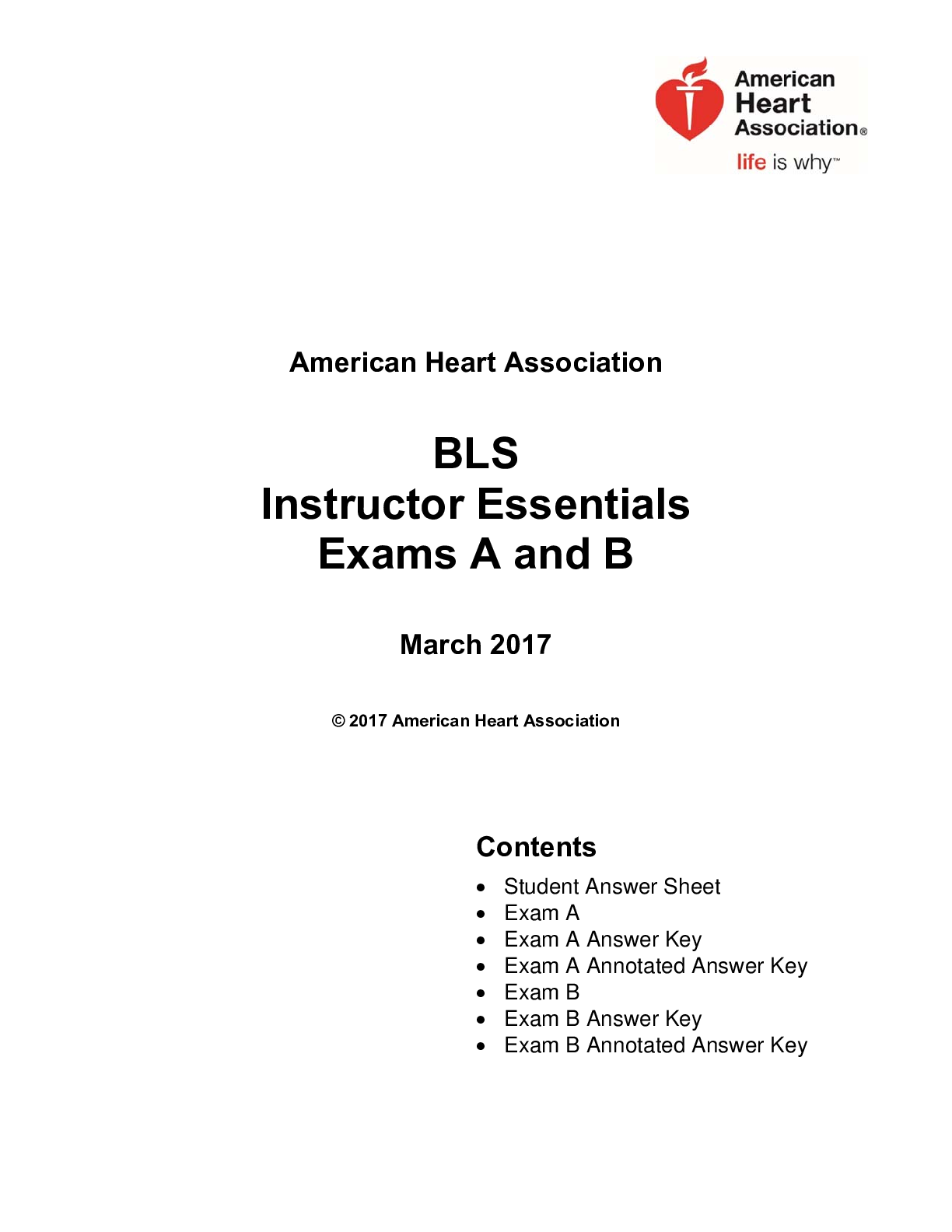
.png)
.png)

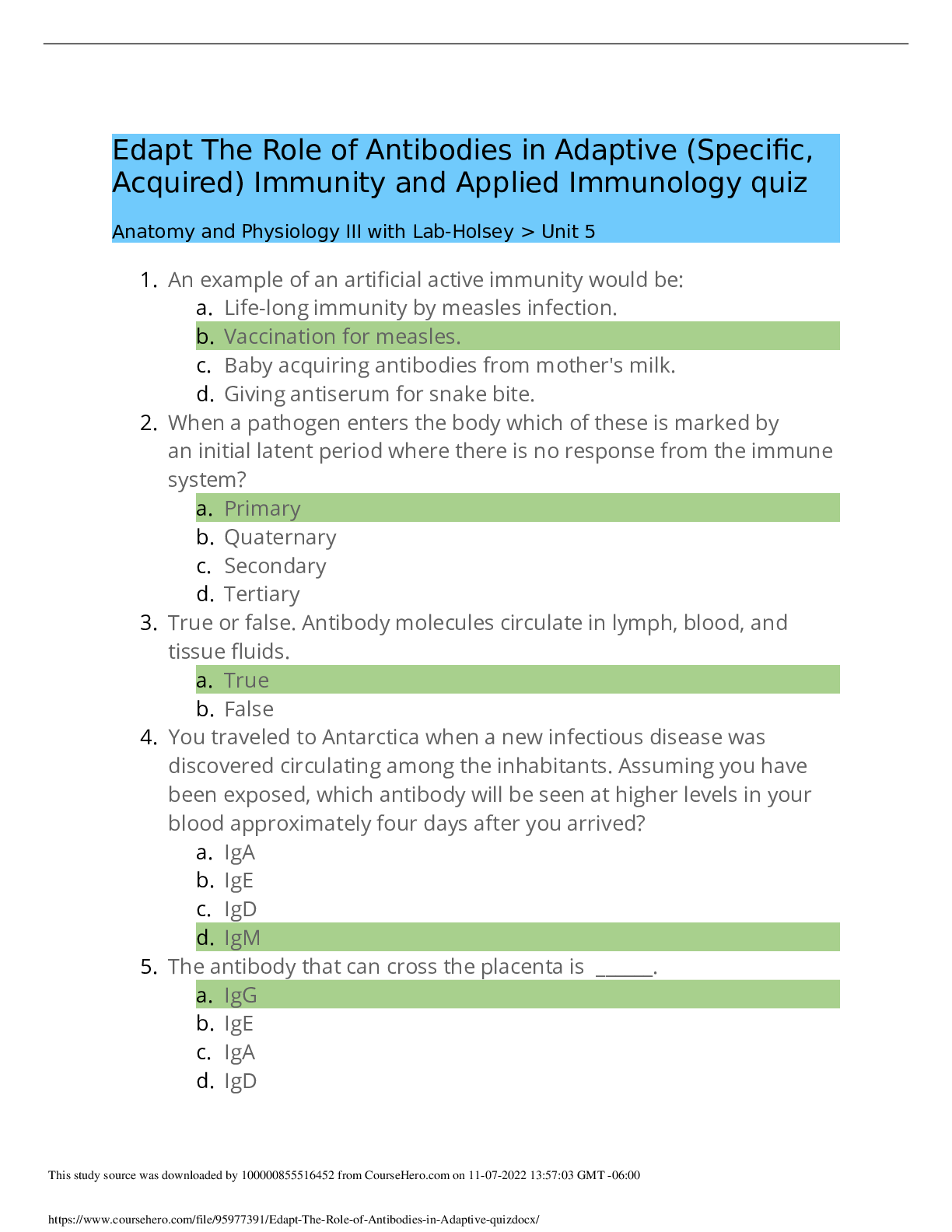
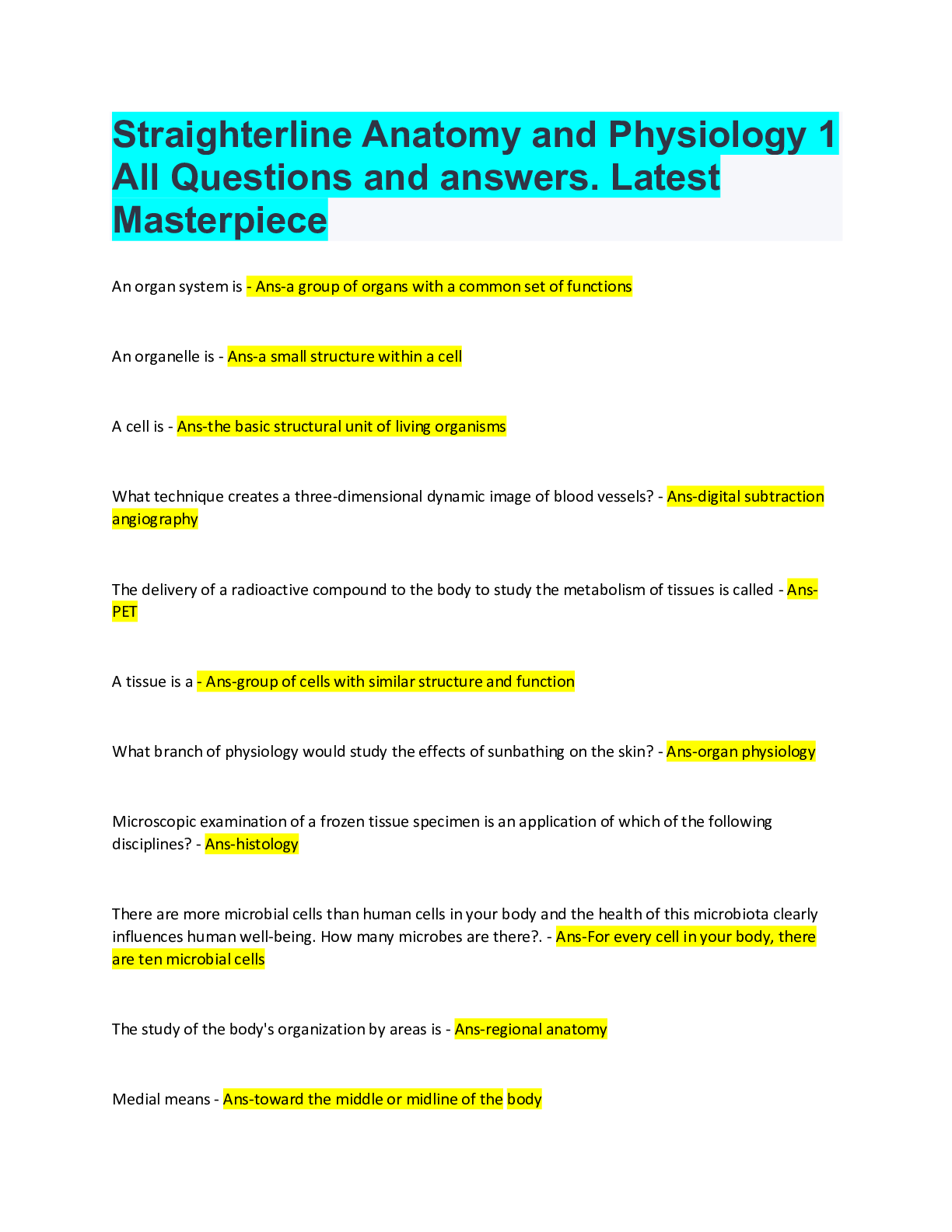
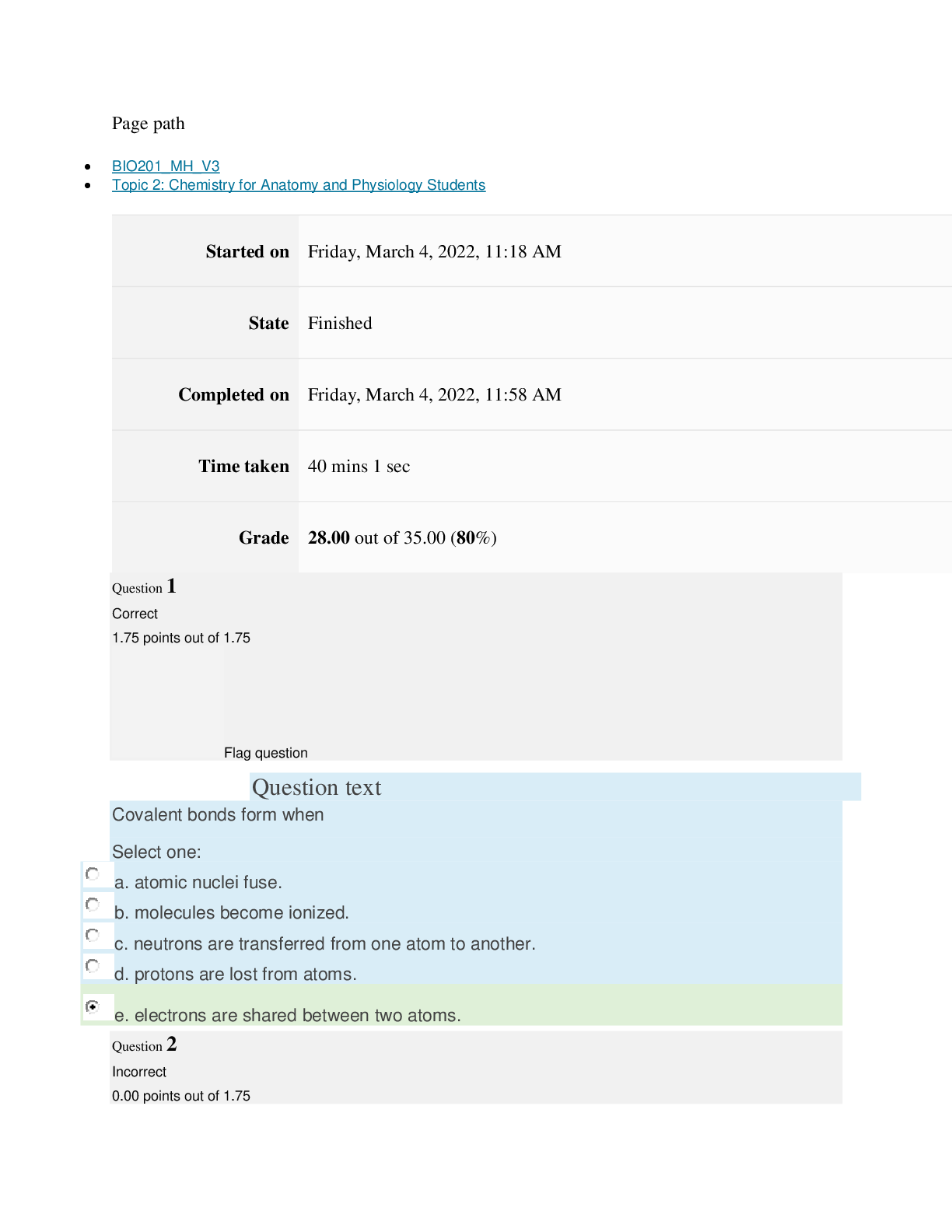
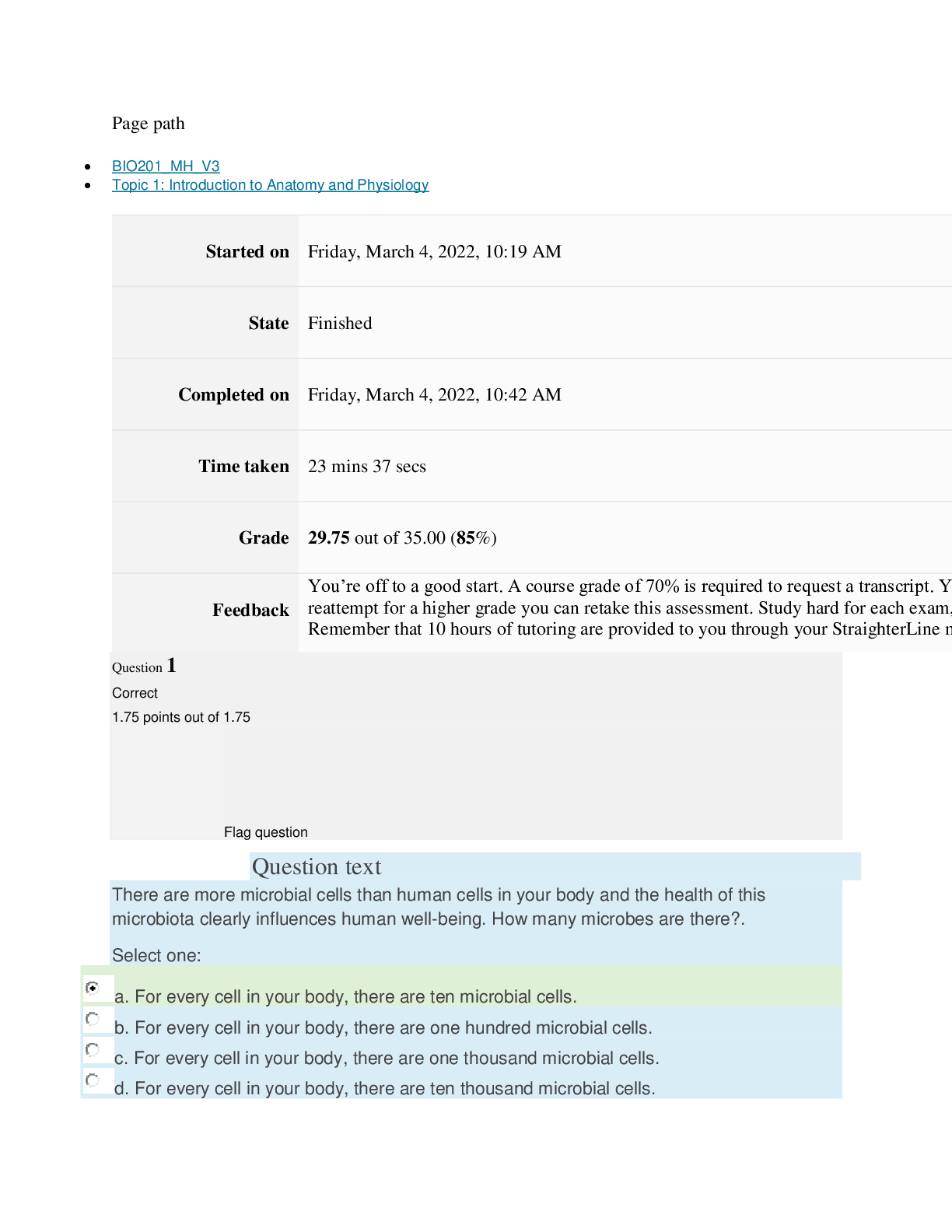

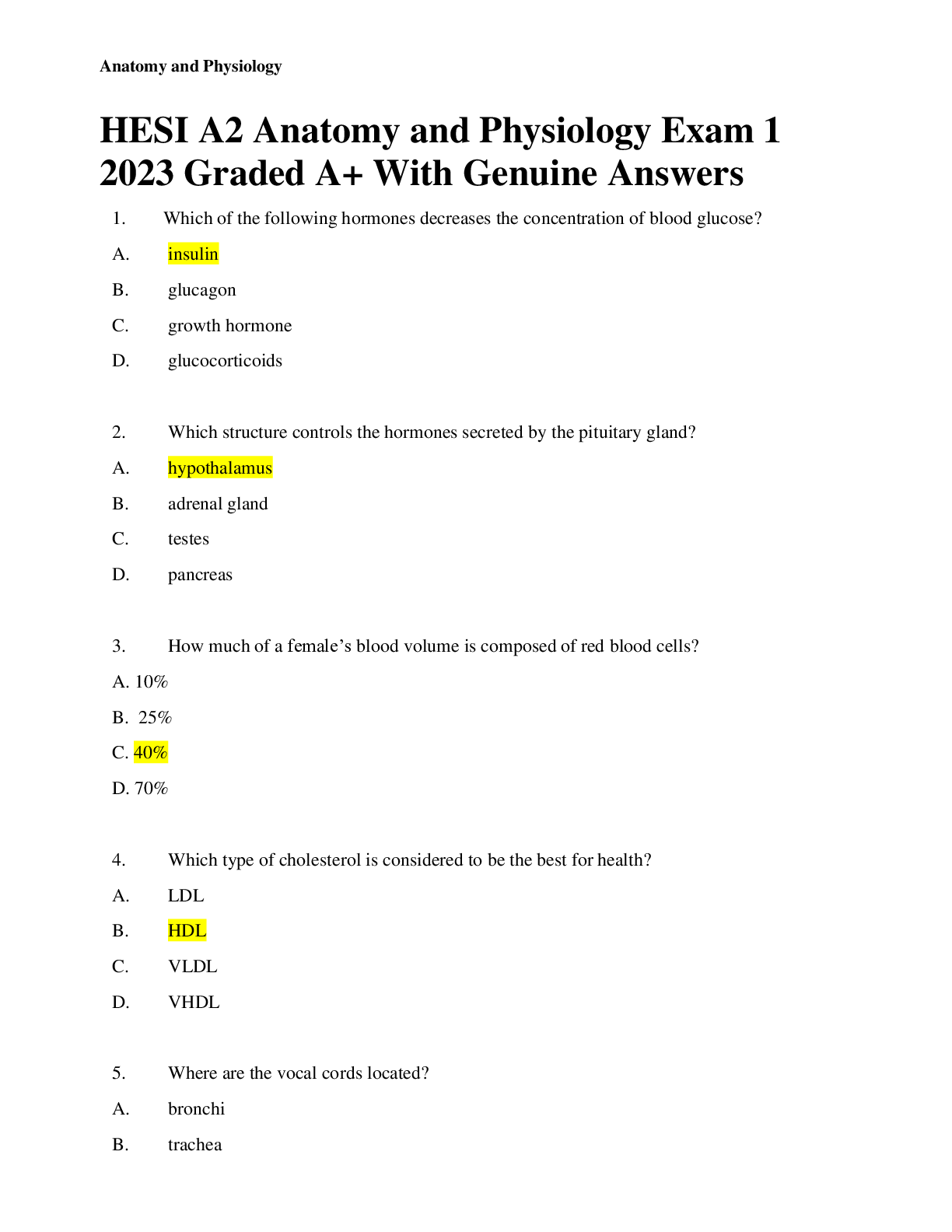
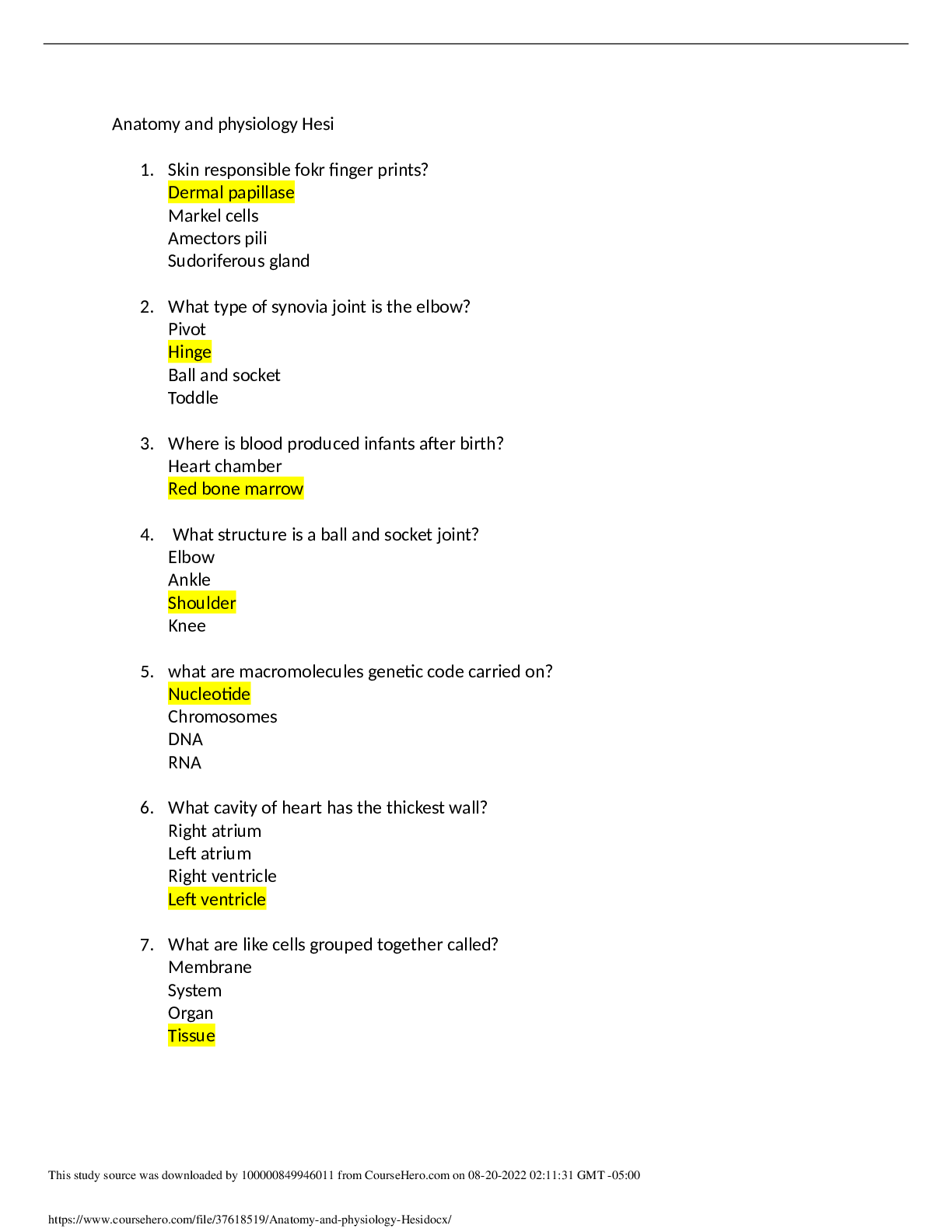
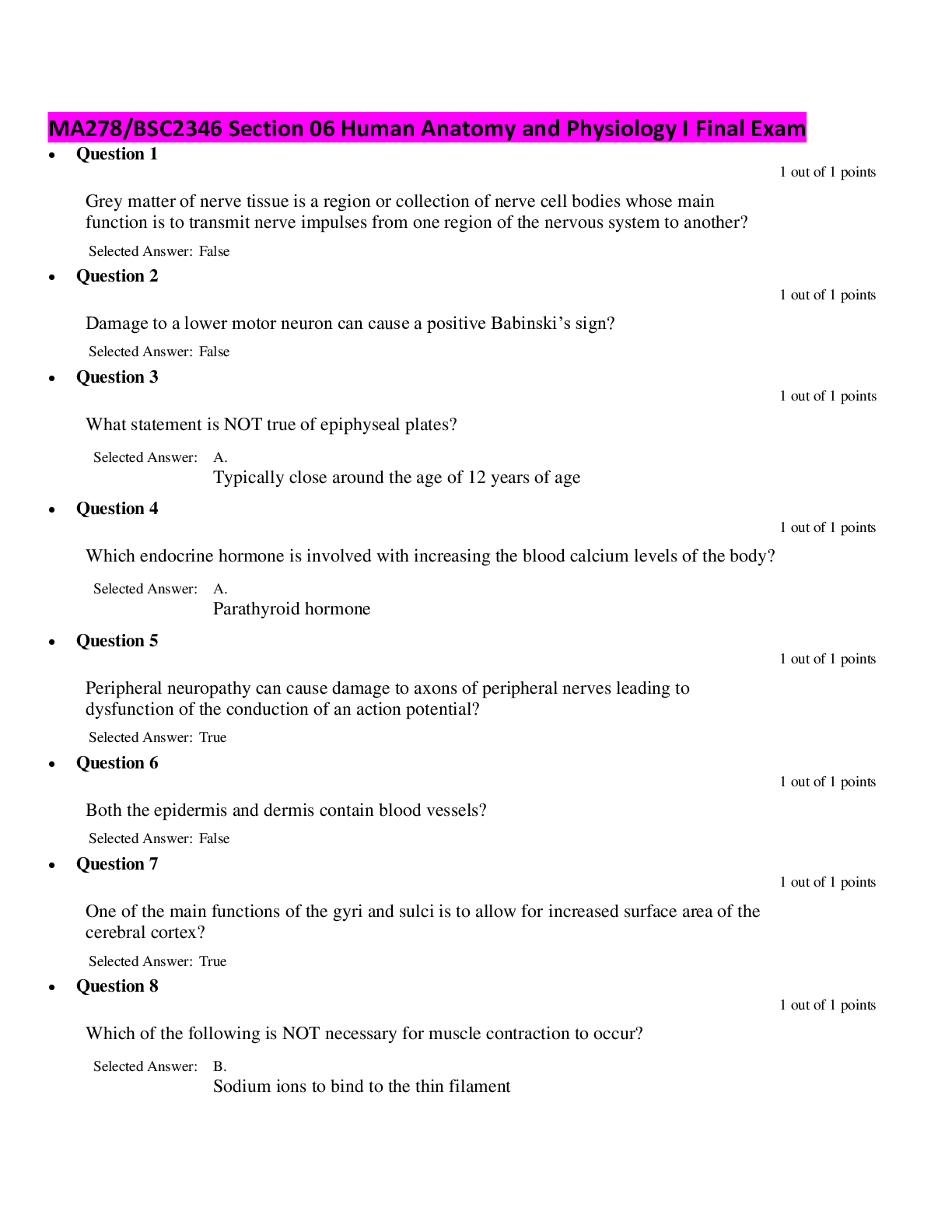
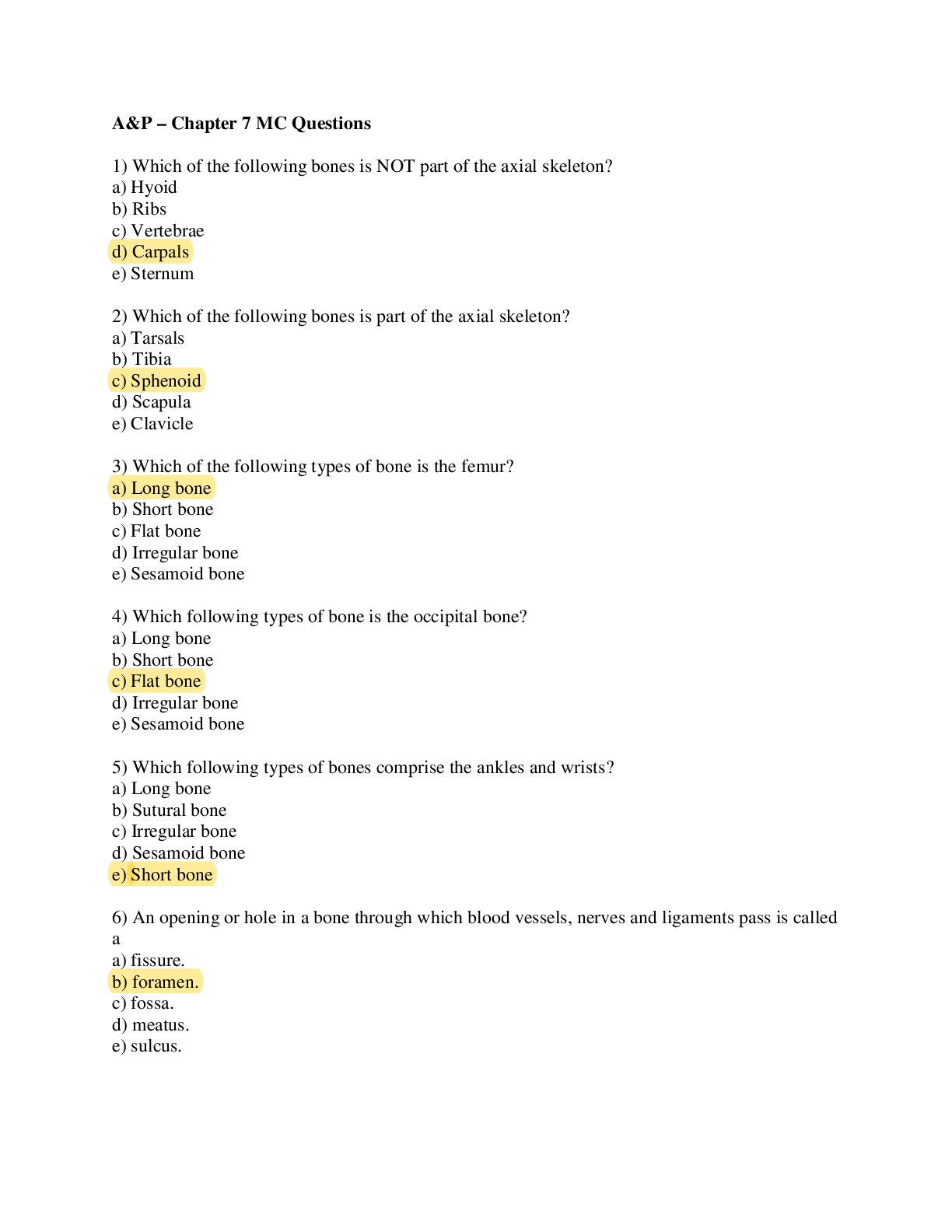

.png)
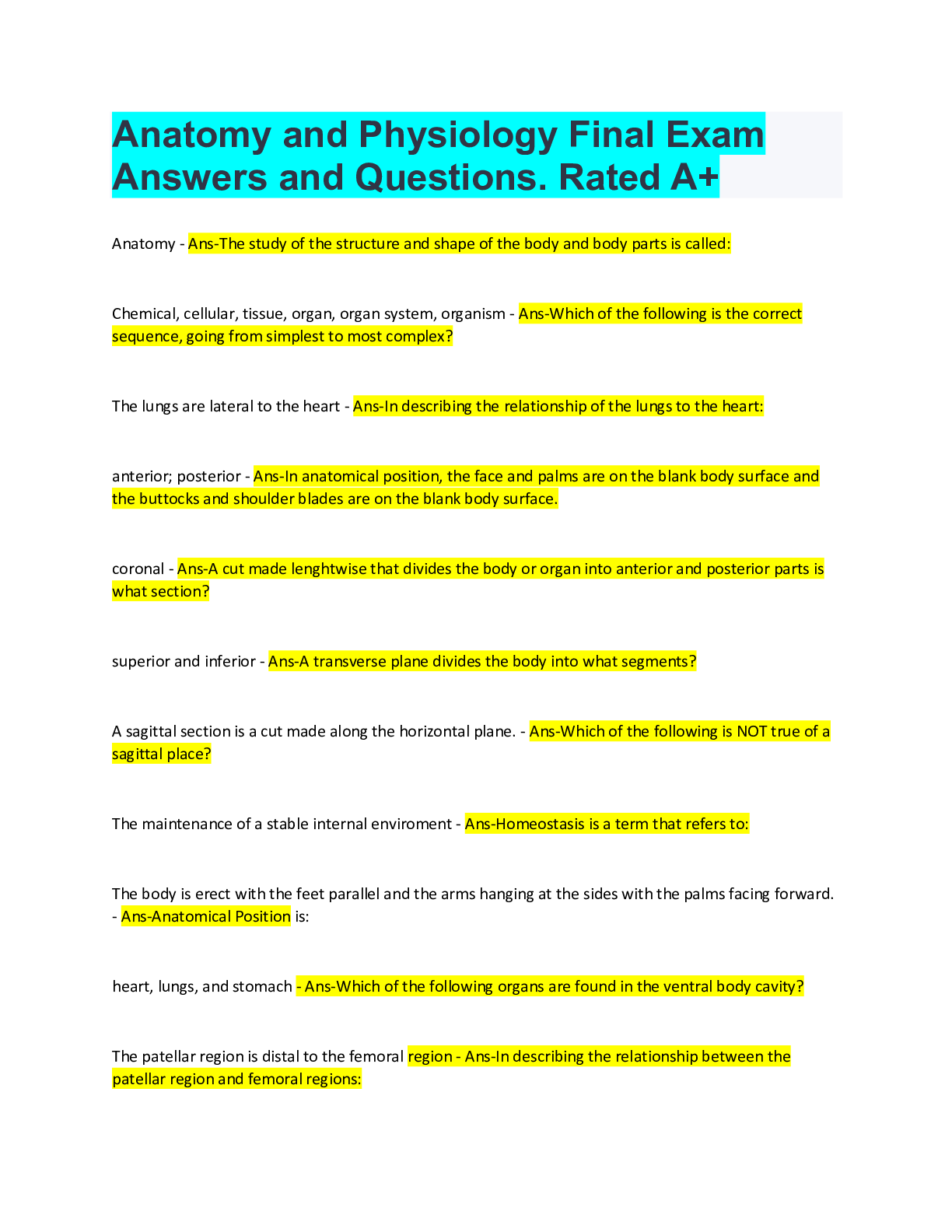
.png)

